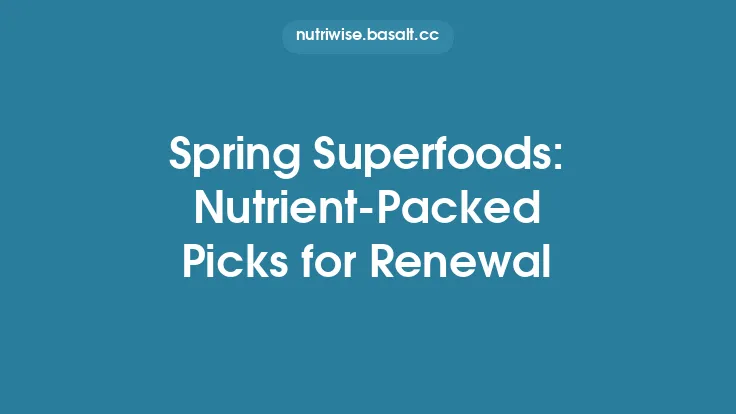The holiday season brings families together around tables laden with rich, aromatic dishes that celebrate cultural heritage and communal joy. While these feasts are a highlight of many traditions, the sheer abundance of flavors, fats, sugars, and sodium can temporarily tip the body’s delicate nutrient equilibrium. After the celebrations subside, the body seeks to restore balance, repair tissues, and reset metabolic pathways. Understanding how to support this natural recovery process can help maintain long‑term health without diminishing the pleasure of future festivities.
Understanding the Nutrient Imbalance After Festive Feasting
During holiday gatherings, meals often emphasize indulgent ingredients: butter‑laden pastries, deep‑fried appetizers, heavily spiced roasts, and sugary confections. This culinary profile typically leads to:
- Elevated caloric load – excess energy that the body stores as glycogen and, eventually, adipose tissue.
- Increased saturated and trans fats – which can transiently raise circulating low‑density lipoprotein (LDL) cholesterol.
- High sodium intake – causing temporary fluid retention and modest elevations in blood pressure.
- Surges in simple sugars – prompting rapid insulin spikes and subsequent drops in blood glucose that may leave one feeling fatigued.
- Reduced intake of micronutrient‑dense foods – such as leafy greens, legumes, and whole grains, which are often displaced by richer dishes.
These shifts are usually short‑lived, but the body’s homeostatic mechanisms need adequate substrates to return to baseline. The liver, kidneys, and endocrine system work together to metabolize excess nutrients, while the gastrointestinal tract processes the increased load of fiber, fat, and protein. When recovery is supported with appropriate foods and lifestyle habits, the body can efficiently clear metabolic by‑products, replenish depleted vitamins and minerals, and restore optimal gut function.
Key Micronutrients to Replenish
After a period of heavy eating, several vitamins and minerals are commonly depleted or require reinforcement:
| Micronutrient | Why It Matters Post‑Feast | Food Sources (Culturally Relevant) |
|---|---|---|
| Vitamin C | Antioxidant that aids in collagen synthesis and helps mitigate oxidative stress from high‑fat meals. | Citrus‑based drinks (e.g., Mexican *agua de limón), kiwi, bell peppers, fermented kimchi* broth. |
| B‑Complex (B1, B2, B6, B12, Folate) | Supports carbohydrate metabolism, red blood cell formation, and nervous system function, all taxed by large carbohydrate loads. | Whole‑grain porridges, lentil soups, *miso soup, sambar* with lentils. |
| Magnesium | Crucial for muscle relaxation, glucose regulation, and counteracting sodium‑induced fluid retention. | Pumpkin seeds, almonds, *dal (lentil) dishes, chickpea* stews. |
| Potassium | Balances sodium, assists in fluid regulation, and supports cardiac function. | Bananas, sweet potatoes, *taro mash, sauerkraut* (fermented cabbage). |
| Zinc | Involved in immune function and wound healing; can be depleted by high alcohol consumption often associated with celebrations. | Shellfish (e.g., *oysters* in coastal cultures), pumpkin seeds, chickpeas. |
| Omega‑3 fatty acids | Anti‑inflammatory agents that help offset the pro‑inflammatory impact of saturated fats. | Fatty fish (e.g., *salmon in Scandinavian traditions), flaxseed porridge, chia* pudding. |
Incorporating these nutrients through modest, culturally resonant meals helps the body replenish what was temporarily taxed without requiring drastic dietary overhauls.
The Role of the Gut Microbiome in Recovery
The gut microbiome—a complex community of bacteria, archaea, fungi, and viruses—plays a pivotal role in processing the diverse array of foods consumed during festive periods. High‑fat, low‑fiber meals can temporarily reduce microbial diversity, favoring bile‑tolerant species such as *Bilophila while suppressing fiber‑fermenting Bifidobacterium and Lactobacillus*. This shift may lead to:
- Increased intestinal permeability (“leaky gut”) that can amplify systemic inflammation.
- Altered short‑chain fatty acid (SCFA) production, reducing the beneficial effects of butyrate on colonocyte health.
- Impaired bile acid metabolism, potentially affecting cholesterol handling.
Restoring a balanced microbiome after the holidays can be achieved by re‑introducing prebiotic fibers (e.g., inulin, resistant starch) and probiotic foods that are part of many cultural traditions:
- Fermented dairy – such as *yogurt in Middle Eastern cuisines or kefir* in Eastern Europe.
- Fermented vegetables – *kimchi in Korean culture, sauerkraut in Germanic regions, pickled radish* in Japanese meals.
- Legume‑based dishes – *dal in South Asian households, hummus* in Mediterranean settings, both of which provide soluble fiber and resistant starch.
These foods not only supply live microorganisms but also create an environment that encourages the growth of beneficial resident microbes, accelerating the return to a resilient gut ecosystem.
Traditional Post‑Festive Foods Across Cultures
Many cultures have long recognized the need for a gentle culinary reset after periods of indulgence. These traditional “recovery” dishes often embody the principles of lightness, hydration, and nutrient density:
- Congee (Rice Porridge) – Widely consumed in Chinese, Vietnamese, and Thai cultures, congee is a thin rice broth that can be fortified with ginger, scallions, and a modest amount of lean protein (e.g., shredded chicken). Its low‑fat, easily digestible nature makes it ideal for soothing the stomach and providing a steady release of carbohydrates.
- Miso Soup – In Japan, a clear broth made from fermented soybean paste offers both probiotics and a modest sodium load. Adding seaweed, tofu, and scallions supplies iodine, calcium, and additional protein without overwhelming the digestive system.
- Lentil or Chickpea Stews – In Mediterranean and Middle Eastern households, slow‑cooked legumes seasoned with cumin, coriander, and a splash of lemon juice deliver plant‑based protein, fiber, and essential minerals. The inclusion of lemon adds vitamin C, enhancing iron absorption from the legumes.
- Barley Water (Kahwa) – In parts of the Indian subcontinent and the Middle East, boiled barley infused with cardamom and a hint of honey is served after large meals. Barley is a source of soluble fiber and beta‑glucans, which can help modulate post‑meal glucose spikes.
- Herbal Infusions – Many cultures turn to specific herbs for their soothing properties: *peppermint tea in Latin America, fennel tea in Italy, and dandelion* root tea in Eastern Europe. These infusions can aid digestion, reduce bloating, and provide modest amounts of antioxidants.
These time‑honored foods illustrate how culinary wisdom often aligns with modern nutritional science, offering a gentle pathway back to equilibrium.
Practical Strategies for Restoring Balance
While traditional dishes provide a cultural framework, everyday actions can further support nutrient restoration:
- Prioritize a “re‑entry” meal within 24–48 hours after the main celebration. This meal should be modest in portion size, rich in vegetables, and include a source of lean protein or legumes. The goal is to supply essential amino acids and micronutrients without re‑introducing excessive calories.
- Incorporate a variety of colors on the plate. Different pigments (e.g., carotenoids in carrots, anthocyanins in berries) reflect distinct phytonutrients that assist in combating oxidative stress generated by high‑fat meals.
- Add a modest amount of healthy fats such as extra‑virgin olive oil, avocado, or nuts. These fats aid in the absorption of fat‑soluble vitamins (A, D, E, K) that may have been under‑consumed during the festive period.
- Schedule short, frequent meals rather than a single large “detox” feast. This approach stabilizes blood glucose, reduces the burden on the digestive system, and supports steady nutrient absorption.
- Limit alcohol intake in the days following celebrations. Alcohol can impair liver function, hinder nutrient metabolism, and exacerbate dehydration. If consumed, choose lower‑alcohol options and pair them with nutrient‑dense foods.
- Mindful chewing and slower eating enhance satiety signals and improve digestive efficiency, allowing the gastrointestinal tract to process foods more effectively.
- Sleep hygiene – Aim for 7–9 hours of quality sleep per night. Sleep supports hormonal regulation (e.g., leptin, ghrelin) that influences appetite and metabolic rate, facilitating a smoother transition back to baseline.
Integrating Light Physical Activity
Gentle movement can accelerate the clearance of metabolic by‑products and improve insulin sensitivity after a period of over‑consumption. Activities that are culturally adaptable include:
- Morning walks – A 20‑minute stroll in a local park or around the neighborhood stimulates circulation and supports lymphatic drainage.
- Tai chi or qigong – Low‑impact, meditative exercises common in East Asian traditions that combine gentle stretching with breath control, aiding digestion.
- Traditional dance – Light folk dances (e.g., *bhangra steps, cumbia* rhythms) performed at a moderate pace can raise heart rate without overexertion.
- Yoga postures – Specific asanas such as *Pavanamuktasana (wind‑relieving pose) and Marjaryasana* (cat‑cow) gently massage abdominal organs, promoting peristalsis.
The key is to avoid high‑intensity workouts immediately after heavy meals, as vigorous exercise can divert blood flow away from the digestive tract, potentially causing discomfort.
Monitoring and Adjusting Over Time
Recovery is not a one‑size‑fits‑all process. Individuals should observe how their bodies respond and make incremental adjustments:
- Track energy levels – Persistent fatigue may indicate lingering nutrient deficiencies (e.g., iron, B‑vitamins) that warrant targeted food choices or supplementation.
- Observe digestive comfort – Bloating, gas, or irregular bowel movements can signal an imbalance in fiber intake or microbiome disruption. Introducing fermented foods or soluble fiber can help.
- Check blood pressure – If sodium‑induced fluid retention persists beyond a few days, reducing salty snacks and increasing potassium‑rich foods can assist in normalization.
- Assess mood and cognition – Fluctuations in blood glucose can affect mental clarity. Balanced meals with low‑glycemic carbohydrates (e.g., whole grains, legumes) help stabilize mood.
Regular self‑assessment, possibly complemented by periodic health check‑ups, ensures that post‑festive recovery translates into lasting well‑being.
Sustainable Post‑Festive Wellness
The period after a celebration offers a natural checkpoint to reinforce healthy habits that can be carried forward into the next year. By:
- Embracing culturally familiar recovery foods,
- Re‑balancing micronutrient intake,
- Supporting gut health through pre‑ and probiotic choices, and
- Incorporating gentle movement and adequate rest,
individuals can restore nutrient equilibrium while honoring the culinary traditions that make each festivity unique. This balanced approach not only mitigates the short‑term impacts of indulgent meals but also cultivates a resilient foundation for future celebrations, ensuring that the joy of gathering around the table remains a source of nourishment for both body and spirit.





